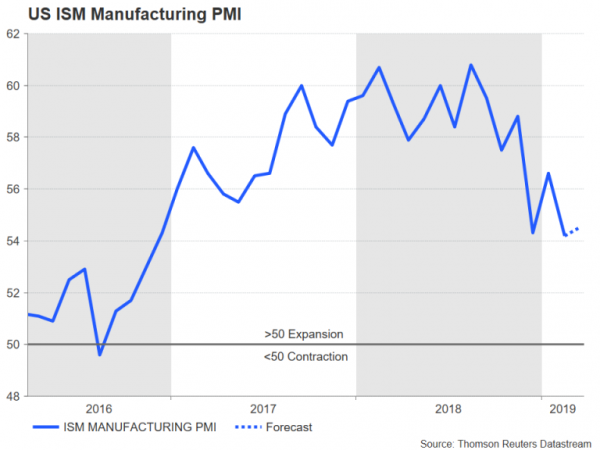Following the inversion of the US yield curve in the past week, retail sales figures and the ISM manufacturing PMI will be attracting attention on Monday as recession fears mount. The retail sales data are due at 13:30 GMT, while the ISM manufacturing gauge will be released slightly later at 15:00 GMT. With the US dollar’s declines so far being fairly limited after the Fed hit the pause button on further rate hikes, the greenback could be susceptible to downside moves if there are negative surprises in the data.
Retail spending slowed in the fourth quarter of last year, with a marked deterioration in December. There was only a weak rebound in January, with retail sales rising by just 0.2% month-on-month. The moderate improvement is expected to have continued in February, with analysts forecasting growth of 0.3% m/m. The alternative measure of retail sales, the ‘retail control’ group, which is used in GDP calculations and excludes volatile items, is seen rising by 0.4% m/m.
Consumer spending is the biggest component of US GDP, contributing to about 70% of economic output. Any signs of a significant slowdown therefore in consumer spending would likely add to market concerns that the US economy could be headed towards a recession. This week’s unexpected drop in the Conference Board’s consumer confidence index in March has already added to the worsening picture.
Another major data point on Monday will be the ISM manufacturing PMI. Manufacturing activity has been on a downtrend since the autumn, but the key indices have remained in expansionary territory. The most closely watched one, the ISM manufacturing PMI, fell to 54.2 in February but is forecast to have increased to 54.5 in March.
A rebound in March would ease worries of a sharp slowdown, at least in the short term, but only marginally. A better-than-expected retail sales figure would also likely provide the dollar with only a modest lift as investors would want to see more evidence pointing to a pick up in the growth momentum before revising their outlook.
The dollar could break above immediate resistance in the 110.70 region against the yen, which is the 38.2% Fibonacci retracement of the downleg from 114.54 to 104.55, if the retail sales and ISM numbers beat expectations. Higher up, the 200-day moving average (currently at 111.45) could also prove easy to overcome. However, the pair would probably struggle to break past the next hurdle at 112.18, which is the 23.6% Fibonacci level, without a more dramatic turnaround in the outlook.
To the downside, a poor set of figures could drive dollar/yen towards the 50% Fibonacci at 109.55. If broken, the sell-off could extend towards the 61.8% Fibonacci at 108.37, while further down the next support could come at 107.50.
The yield spread between 10-year and 3-month Treasury notes turned negative at the end of last week, raising fears of a deep downturn. An inversion in this particular part of the yield curve is widely seen as a reliable predictor of a recession and the dollar could see increased volatility to incoming data as long as it remains inverted.















